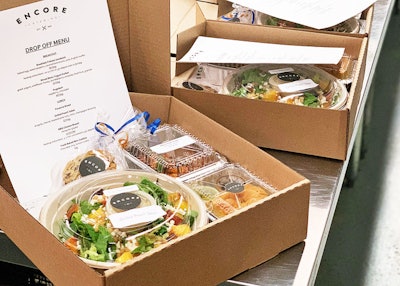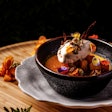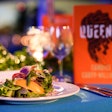
The catering industry is no exception to the pivoting that’s happened due to the pandemic. Over the last year, catering companies, like the rest of the world, have shifted. In lieu of traditional buffets or plated meals at 10-tops, the boxed meal has become a convenient option for safe service. This has prompted caterers to get creative with menus and presentations in order to deliver a top-notch dining experience in a grab-and-go situation.
Here are some best practices for event planners offering boxed meal service.
1. Careful menu selection is essential to building a boxed meal that will be received well by attendees.
Pay particular attention to what will work well within your packaging and temperature restrictions. “You have to design your menu to work with the box,” says Doug Biggs, president of DJ’s California Catering in Ventura, Calif. A menu for meals packed in clamshell containers with three compartments will be very different from a menu for boxes with no compartments, he notes.
“Don’t include anything with heavy grease that could soak through the packaging,” warns Robert Mitchell, executive chef of Bold Catering & Design in Atlanta. You’ll also want to stay away from heavily breaded foods that become soggy when closed in a box with steam.
“You want to include foods that can be enjoyed slightly chilled or at room temperature,” Mitchell says. “Combo salads with grains, greens, dried fruits and nuts mixed together work well, or meat that’s thinly sliced like beef, lamb or even pork loin.” Charcuterie, fruit and hummus are other crowd-pleasing menu items that have held up well in Mitchell’s boxes.
Lisbet Halvorsen, owner of Seattle-based Ravishing Radish Catering, encourages her clients to think of their boxed menus as “picnic style.” “Think roasted potato salad, not mashed potatoes,” she says. “Pork, chicken or beef skewers, braised meats—you want to include things fully cooked that won’t lose quality over time.”
Once you’ve landed on a menu, consider what adjustments can be made in order to uphold the integrity of the food for as long as possible. For example, Mitchell recommends using a mayonnaise-based spread on any sandwiches that include tomato in order to keep the juice from seeping into the bread. Avoid limp lettuce by including dressing in a small container rather than pre-dressing your salads.
2. Communication is key for addressing dietary needs.
Without an on-site kitchen or buffet where guests can select what works for them, how can planners accommodate dietary restrictions for their attendees?
“Labeling is really important, but so is a well-planned distribution process,” Halvorsen says. “If everything is labeled clearly but the volunteers or staff delivering the food aren’t briefed, meals end up in the wrong hands.” Halvorsen had this experience with a museum fundraiser she catered. She dropped off the boxes and then watched well-meaning volunteers jump in to distribute the boxes quickly without noticing the labels.
Mitchell and his team opt to build one-size-fits-all boxes as often as possible. “Making the whole box meet the major food allergens is the easiest thing to do,” he says, sharing that he avoids menu items containing gluten and dairy when he can.
3. Presentation still matters.
A boxed meal does not give the catering company or the planner the luxury of making a statement with stunning table settings or creative buffets. So, chefs and planners need to dream up different ways to wow their attendees.
“One of our priorities is presentation, so we try to put a bed of greens or a slice of kiwi in the box, or even a fresh flower,” Halvorsen says. “We want to deliver a mini experience like they would have with [my company].”
All five senses should be considered in presentation, not just the appearance of the boxed meal. “Stay away from seafood or boiled eggs,” Mitchell cautions. “The minute you open the box, that’s all you’ll smell.”
4. Timing is everything.
Planners, caterers and venue staff should work together so the boxes can be delivered as close to the time of consumption as possible in order to serve your guests a boxed meal that’s enjoyable and safe.
Rather than one large pickup location, consider creating several stations around your venue where attendees can pick up their box, suggests Bold 's director of sales Heather Hofmann. This will cut down on a line and prevent the need for one huge staging location for all of the bulky boxes. Staggering mealtimes for segments of your attendees is another option that will reduce the space needed for storage and allow for fresher meals. The caterer can do multiple deliveries, bringing each batch of boxes as close to mealtime as possible.
If space permits, consider asking the catering team to assemble the boxes on-site. On Veterans Day, Biggs’ company was hired to prepare 300 hot meals for a drive-in event for veterans and their families. The food was to be consumed by the attendees in their vehicles midway through the event. Instead of preassembling boxes that would have to sit for over an hour, Biggs and his employees opted to bring all of the food on-site in bulk with warmers and set up a canopy for assembly. The team was able to build boxes at a pace that worked for the flow of guests as they grabbed them—avoiding a big pile of boxes with nowhere to stay warm.
Planning an all-star boxed meal service for hundreds (or thousands!) requires equal parts logistics and creativity. With critical thinking and a willingness to stretch their minds, caterers and planners can build a box that attendees will remember for all of the right reasons.
A version of this story appeared in Connect's spring 2021 issue.



















